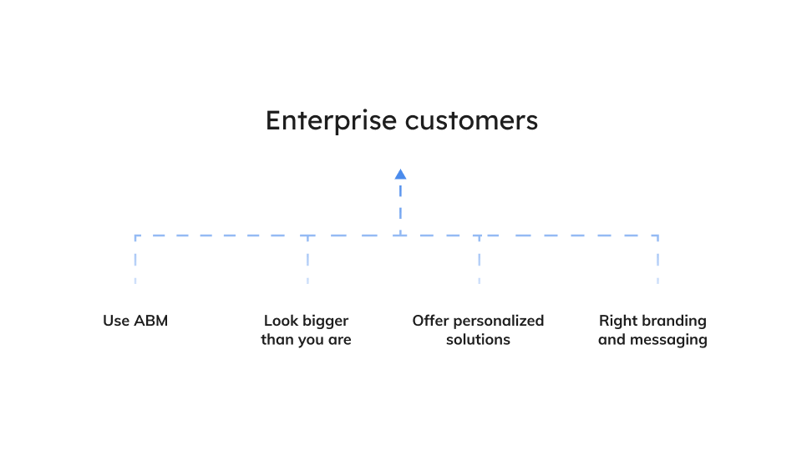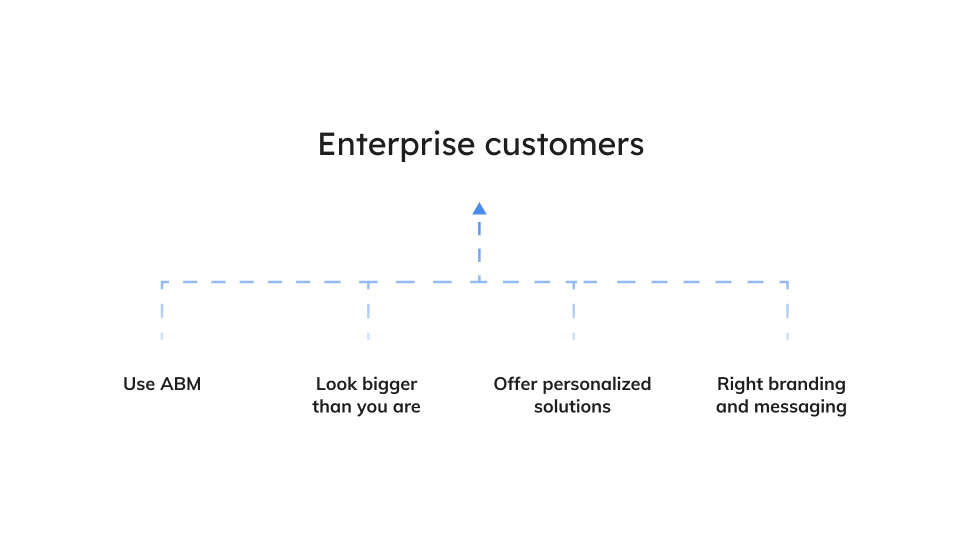For SaaS start-ups, every single lead and closed-won is a major milestone.
At Kalungi, we're often asked how B2B SaaS start-ups and SMEs can win contracts with larger enterprises.
Let's explore the benefits of winning an enterprise's business, and the best ways to ensure that your efforts succeed.
Why Target Enterprises as a SaaS Company
Enterprises are considered large corporations that manage hundreds to thousands of employees, have complex workflows and systems that might connect global offices and individuals. They’re unique because they have large budgets, so they can be relatively flexible when it comes to investing in new technology.
Because of their size, complexity and cash flow, enterprises make great customers for small to medium-sized businesses in SaaS and other industries. Enterprises typically seek a top-shelf product that’s designed to be scalable and comprehensive, so they expect knowledge-intensive services and support.
Thus, an “enterprise-level” SaaS solution is positioned as a powerful, scalable and secure product with extensive knowledge. This requires a significant up-front investment in time and money, but also in the long-term as you spend time and resources supporting their use and retaining them as customers.
There are many benefits of acquiring an enterprise-sized company, but it can be daunting as a start-up. Let's cover four tips to help you win an enterprise-sized account.
Four Tips to Win an Enterprise Account for Your B2B SaaS Start-Up
If you’re trying to secure an enterprise-sized company as a customer, consider the following options to attract new leads:

1. Use Account-Based Marketing (ABM)
This is a relatively new strategy for generating outbound leads by using personalized campaigns designed to engage with each account and connect with the people you want.
You can do this by using content marketing + brand awareness to attract people into your funnel, but you’ll have all types of leads and many may not fit your ideal customer profile.
That’s why outbound ABM is the best way to find enterprise-sized customers -- if you know who your ideal customer profile is and you know the attributes of those enterprises, you can target other companies that would be a good fit for your company with the right type of messaging, content and channels (LinkedIn, Facebook, etc).
When executing ABM, make sure you reach out to multiple people and roles within each company, because larger companies mean more complex decision-making processes. You can find out what your ICP might look like through analyzing your total addressable market, serviceable addressable market, and serviceable obtainable market (TAM, SAM and SOM), or make a database with the attributes of your current customers to understand what companies best fit with your product.
To learn more about moving your software product upmarket, check out our podcast B2B SaaS Marketing Snacks, Episode 3: What changes from SMB to Enterprise? How do you move upmarket?
2. Look Bigger Than You Actually Are
You need to position your company as a credible, trustworthy and experienced industry presence. To do this, it’s crucial to implement consistent brand standards across color use, logos, font, and other areas of design and communications.
Even updating your company's 'About Us' page, have your employees update their LinkedIn profiles, and using your marketing communication channels regularly can show enterprises that you're a well-established, high-functioning company with plenty of talent and resources.
By making sure you’re appearing professional and consistent, you’re building an image to show up with enough credibility and gravitas that will attract others.
3. Create + Showcase Unique Solutions
Enterprises don’t just want off-the-shelf, out-of-the-box products that are consumed by everyone else for their IT infrastructure. Enterprises need unique solutions that can scale to protect their users and data with a solution that’s centrally managed and supported on-premise for the company’s HQ.
When you offer a unique solution for your customers, it’s important to understand their pain points and dreams. Position your solution so that it fulfills your three personas’ needs and wants, and clearly communicate the personalized value you’re delivering. Your content team and product team must work closely together to create a well-rounded solution that’s uniquely tailored to the enterprise’s needs.
Just as personalization is effective for account-based marketing outreach, personalizing your content, solutions, and support will help you win market share from larger, more established SaaS providers.
4. Use the Right Logos on Your Website
If you have other larger organizations or enterprise-sized customers, you should use their logos on your home page, customer page, and testimonials.
By showing enterprise-sized leads that you serve other companies like them, your enterprise prospects know who has gone before them and that you can serve them adequately.
If you’re focused on acquiring enterprise customers, it’s easy to focus on a vertical, a specific use case, or a problem unique to large organizations. If you do this well through the right messaging and content around the pain point you solve for and what your customers stand to gain, this can be enough to get your customers.
Acquire Your Dream Customers Through a Balanced Marketing Function
Finding the balance between inbound and outbound marketing is tricky for start-ups and enterprises alike.
Prepare your SaaS start-up for hockey stick growth with Kalungi’s proven B2B SaaS marketing playbook. From start to scale to profit, you’ll have SaaS marketing experts guiding you every step of the way.
